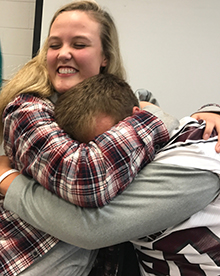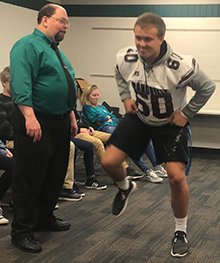Certified hypnotist Michael Brody asked a dozen students to visualize themselves in several scenarios: a gorgeous beach day with a surfer catching waves; bouncy with anticipation for their third birthday with an invitation to suck their thumbs; and a dance-off with Brody playing the Bee Gees’ “Stayin’ Alive” and Village People’s “YMCA” on his laptop.
In a large second-floor lecture hall, the students laughed and boogied down with their hypnotized classmates. But it was a senior’s sumo wrestling bit that brought the house down.

With parental permission, Brody slowly introduced hypnosis to psychology students at the high school. Psychology teachers Laura Vrba-Carrick and Kristin Bridges organized the session as a fun way to explore and critically analyze the different theories on hypnosis. This helped explore the states of consciousness, which is an objective for AP Psychology and Psychology II.
Brody — also a certified elementary teacher — started with a susceptibility test by asking the students to relax their minds and bodies. Though the hypnotic state isn’t dangerous, Brody advised those students who were overly tired, injured or taking medication for medical conditions to forgo participating in the group hypnosis.
“I’m looking for the best visualizers,” Brody said, selecting students who seemed more likely to give hypnosis a fair chance. With students seated in a single row and facing their classmates, Brody played relaxing music on his amped-up laptop and encouraged the students to stare at a bank of classroom lights.
“Focus on just yourself, my voice and nothing else,” he said. “It’s as simple as breathing in and out. Breathe in through your nose and out through your mouth. Feel a relaxing sensation. Drift deeper and deeper into relaxation.”
He then counted down: “Five, four, three, two, one — snap,” with a snap of his fingers. “All of you are in a state of relaxation that we call hypnosis.”

The Unconstrained Mind
One theory of hypnosis is called “divided consciousness,” said Vrba-Carrick. “The hypnotic experience is explained by equating consciousness to something like a sleep state, different from our fully conscious, fully awake self.”
Another theory holds that hypnosis is “all role-playing,” she said. “We get our ideas on hypnosis from the media and/or other cultural sources, and then act out the corresponding social role when placed in the appropriate situation.”
Added Bridges, her fellow psychology teacher, “We can go into a hypnotic state every day without knowing it. Like when you’re really immersed in a good book or movie, daydreaming, or being in class where your mind just wanders a little and five minutes passed without you noticing at all.”
A Hilarious Face-off
But there was no daydreaming when hypnotized senior Bryce Bouwens went into full-on grappler mode.
“You are a sumo wrestler and you have come to town to challenge someone from the audience,” Brody told him. “You speak in sumotalk? Tell us your name?”
Bryce grunted out his name. Brody suggested that Bryce “pick out someone who is worthy to challenge you.”
Bryce assumed an Incredible Hunk position and stomped to the back of the room, hunched before a fellow football player and slapped the ground, throwing down his challenge. On opposite sides of Brody, the pair faced off in the front of the room.
“The minute that you scream that sumo wrestling scream, you are not a sumo wrestler anymore,” Brody said. “OK, here we go – boom boom!” Bryce snapped out of it.
His thoughts afterwards: “I’m feeling a little tired. It was fun and I’m really relaxed right now.”

Students Control Experience
Brody emphasized that no one is forced to participate, and no one under hypnosis can be made to do something that they don’t want to. All hypnosis is really self-hypnosis, with even susceptible students controlling the whole experience, Brody added.
“So we’re targeting states of consciousness, learning about how the brain works and the difference between conscious, subconscious and unconscious states,” Brody told the class, referencing Sigmund Freud’s model of the human mind.
“Think of your subconscious like a file system, and your file system stores all of this information that you can retrieve anytime that you want. So if you’re under hypnosis and I give you a suggestion, then you can accept that suggestion because you understand it.”
As an observer, senior Rylee VanderLaan found the hypnotic session fascinating.
“It definitely opens your eyes to the kinds of observations that you can make in psychology,” Rylee said. “There’s so much more to the subconsciousness than I knew.”
CONNECT
American Psychological Association on Hypnosis










